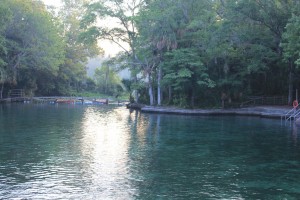June 11, 2011 – Wekiwa Springs
Location: Wekiwa Springs State Park Apopka, Florida
Author: Shawn Hill
Today the Cambrian Foundation, in conjunction with Virginia Commonwealth University (VCU) and University of Virginia (UVa), gathered for the ongoing research project at Wekiwa springs. Wekiwa Springs State Park (www.floridastateparks.org/wekiwasprings) offers recreational activities such as swimming, kayaking, and camping, but also serves as a long-term monitoring site for our project examining the diversity of microbes in submerged cave communities. Wekiwa Springs is a good representative of the Floridian aquifer in central Florida and can provide an insight to biogeochemical activity within karst environments.
The group convened in the morning hours before the Park opened to the public. Two main stations were designated with the purpose of carrying out the investigations for the day: water chemistry/sample storage and sample collection. Once station setups were complete, the team set their objectives on prepping bags that the technical dive team would need in order to accomplish the goal of sample collection from within the subsurface cave. The dive team would be collecting an array of information that would include: water chemistry, water samples, and bacterial mat samples. Because of the type of technical diving involved in the collection process, pre-dive plans to assign roles and dive walkthroughs took place to detail the steps to complete a safe and successful dive.
When preparations were completed, the dive team started by collecting the first samples of the day located at the mouth of the cave. There would be six sites within the cave that the technical divers would sample from: the mouth and five sites from the interior. Sampling sites had been determined by previous field trips to the springs. While the dive team was beneath the water, samples would be continuously brought up to the surface teams in order to store bacterial samples and establish field chemistry measurements. Water chemistry measurements taken in situ were alkalinity, ammonium, sulfide, and iron. Once all samples had been collected the dive team returned to the surface and began packing and cleaning equipment.
After the team completed its goals for the day it was time to debrief and discuss the events of the day. The group discussed what worked and what could possibly make the trip better for us and for the public. At this point it was time for sandwiches and to take a dive into the springs for a bit of relaxation.
Thank you to the staff at Wekiwa Springs State Park and District 3 Park Staff for your continued support! It is a pleasure working with you!
Questions/comments to the Trilobite??
Team:
Rachel Crane, 2011 Frank Scalli Intern/Boston Sea Rovers
Steve Dunn, CF Intern/Rollins College
Jef Frank
Rima Franklin, Ph.D., VCU
Amy Giannotti
Shawn Hill, VCU
Alex Houston
Aaron Mills, Ph. D., University of Virginia
Renee Power
Jenny Sherwood
Karl Shreeves
Amber Taylor, VCU
Andrew Vossler, CF Intern/Rollins College
Marissa Williams








